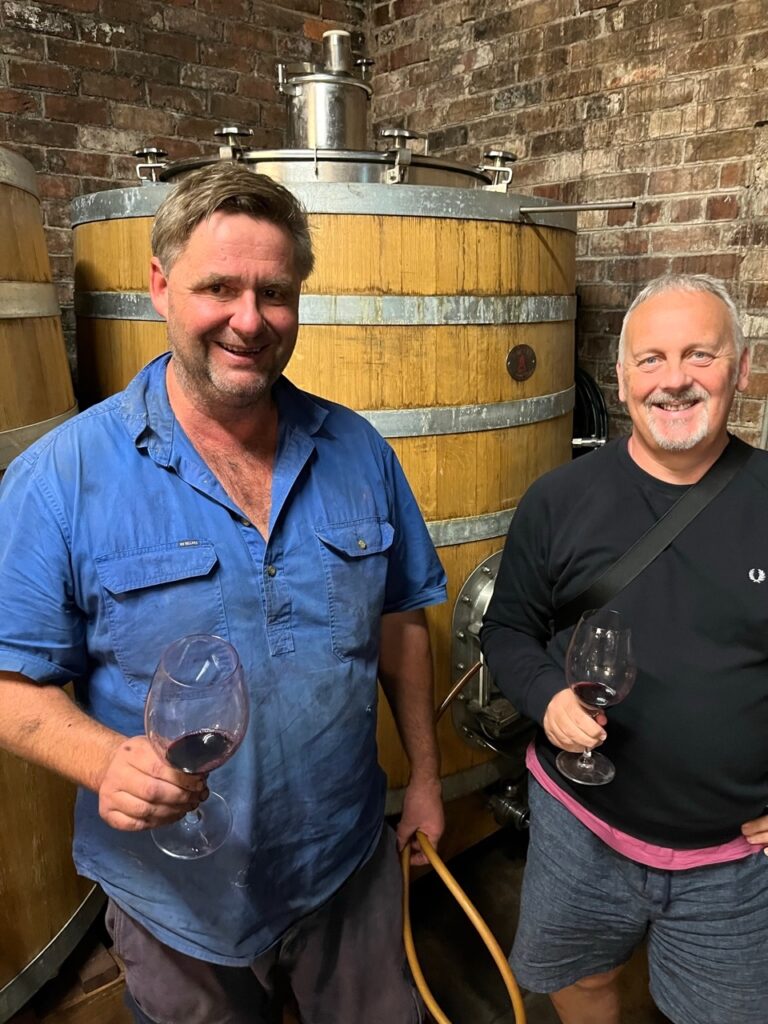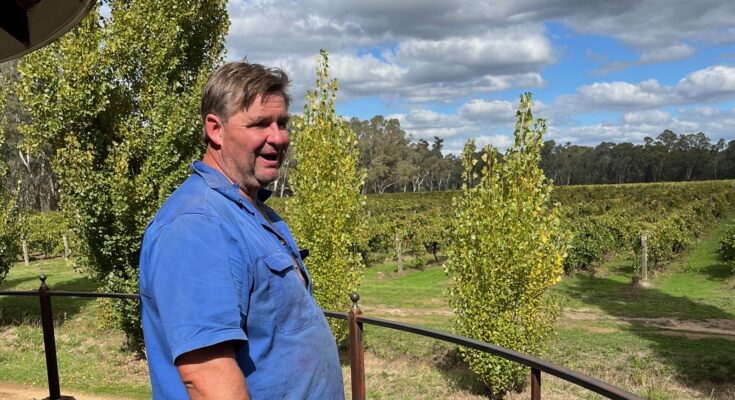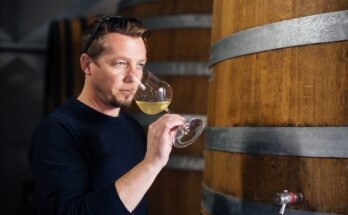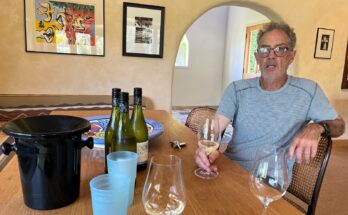I arrive after a drive through the back roads of Heathcote to meet Simon Osicka at his family-owned property. Paul Osicka Wines was started by vigneron Paul Osicka in 1955 and is acknowledged as the longest established wine producer in the Heathcote Wine Region. The wine is largely estate grown, made and bottled by Simon, who is the third generation of the family – originally from Czechoslovakia.
The ‘staff’ who run the place is pretty much Simon, plus a couple of older neighbours who have retired, who chip in. Simon does all the pruning across the whole vineyard – he learnt at his father’s side. We walk past some construction work, and Simon explains: “Building – I’m sick of seeing all our equipment sitting out in the rain. The original shed that my grandfather built, and where he used to have his cellars, has almost fallen over.” The building was put up in the 1960s, and although it gets cold in winter, they have a fireplace. It was an old railway station that was demolished and Simon’s father rebuilt it, piece by piece, on their land.
Simon tells me that this year they had water over the whole vineyard and through the whole place. They’ve never had water in the cellar before, but the vines were actually chest height in water. Add to that finding big logs in the vineyard! That’s as well as it having rained pretty much all of last year, with them spraying the vineyard every week (but one) right through to the end of September. Then, of course, it was amazingly dry and perfect 28 degree days every day. Until 40mms of rain arrived five days before picking. Once one parcel got a bit of flavour they would pick it, then wait for another parcel – in all five picks across what seems like quite a compact block. They had just finished picking when I got there.
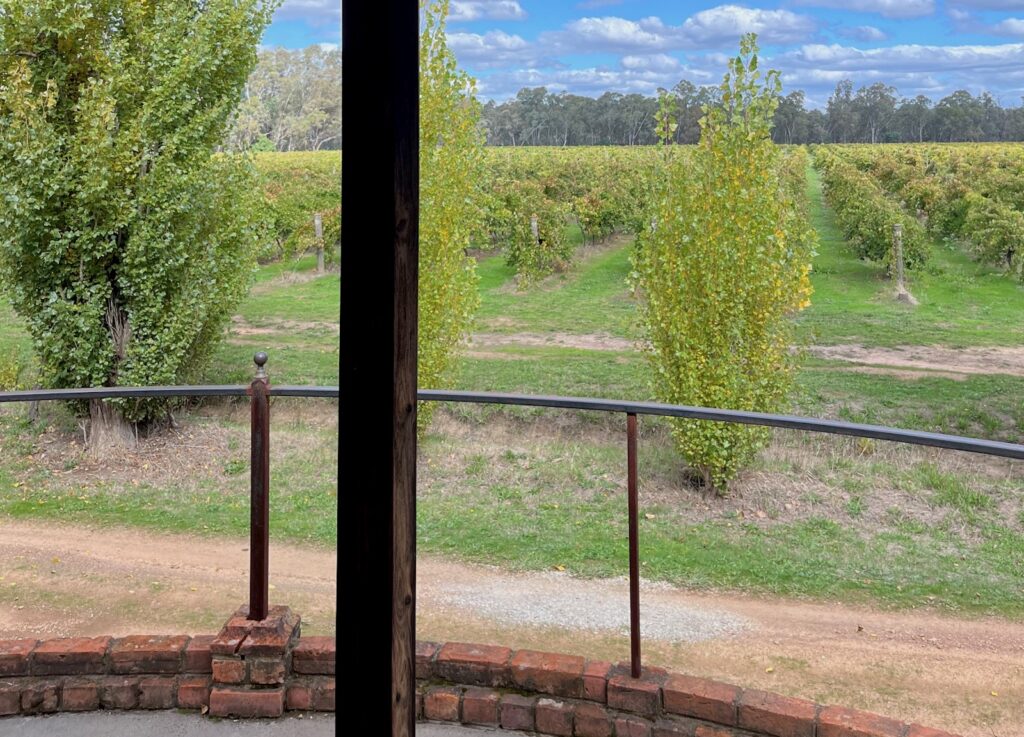
Soils are a lot of quartz and granite, with buckshot gravel. Parts are alluvial where there’s an old creek bed. The front part of the vineyard has deeper soils which can take a lot longer to ripen – in some years it can be two weeks between the front and the back. Some years just a few days, depending on how warm it is. Each vintage is different. This is a year where things just worked out. Paul says “Yes, I’d banked it before we had that rain. I thought ‘I deserve this’. We had such a terrible year last year. I’ll be talking it up to be a great vintage in two years when it comes to selling it, hahaha”.
Over the way is a small, very pretty vineyard of Grenache bush vines that was planted in 2017. It is planted in a very particular grid – called a ‘Queens Cut pattern’ which allows them to use the ride-on mower and mow around the vines really neatly, without needing to use herbicide. When the family took over the property, the original owners, the Kennedy’s, showed them a book from the 1890s. ‘A Guidebook to Viticulture in Victoria’, written by a Swiss Viticulturalist, Frances de Costella, who had been brought to Australia to try and re-establish grape growing in the region. In the book, it has the pattern, and Simon discussed it with his dad when they were talking about planting the vineyard. Simon thinks there may only be one other vineyard that is planted like it in Australia.
Grenache is a late-ripening variety but the last two seasons it has been the first red grapes they’ve picked! The first year they picked it, they’d been expecting a lot of rain, and the Grenache wasn’t quite there, but they decided to pick it and see. It had 13.2 potential alcohol, but the wine ended up with remarkable colour and depth to it. So they’ve followed that path with subsequent vintages.
In the winery is some new sorting and de-stemming equipment. They do all the picking by hand into small bins, which go into the cool room overnight, to be processed the next day. The vibrating table gets rid of a lot of the material that comes in with the grapes. Through the destemmer which has plenty of variable settings, and ending up with just the ripe, whole berries – the unripe ones, along with the ‘other matter’ clinging to the stems is removed by the machine – overseen by a team member. I take a look at a vat of Cabernet Sauvignon that has been fermenting for two weeks, and is still showing lots of whole berries. Simon jokes that “if someone visits during vintage, a good game is – I give them a plunger – and because it is whole berries, it’s like trying to plunge concrete!”
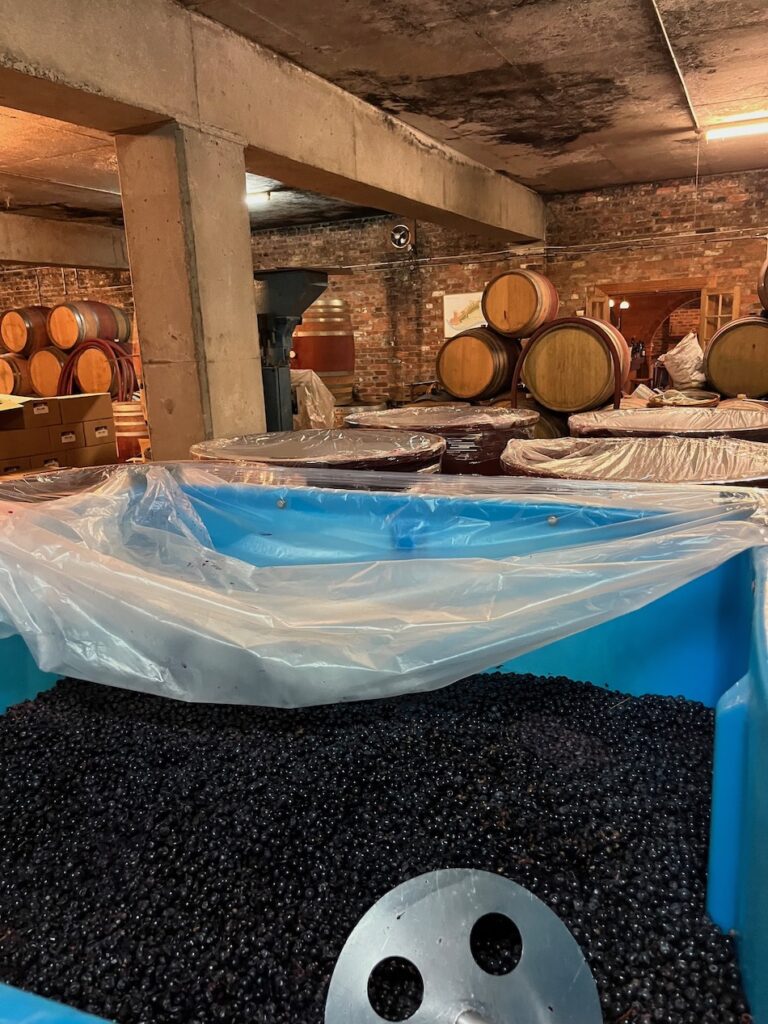
They pick the various parts of the vineyard separately, keeping the various parts across a range of fermenters, including large format cuves. A brand new pick from Saturday is opened and I taste the berries inside. They’ll break up just a little bit to get some fermentation going, and then just leave them. Another vat has just had the berries broken up that morning – the flavour is excellent, the pips ripe. The new machine has really allowed them to change up their winemaking. And Simon thinks “For the better. Gives us more fragrance and lift to the wines. It’s quite easy to make impressive, powerful wines in Heathcote. It’s not always that easy to make wines that are a bit more seductive, and have a bit more perfume and interest”.
Typically, their wines will spend about three to four weeks on skins. Simon worked a vintage in Hermitage, at Domaine Jean-Louis Chave, in 2010; and saw the technique and length of timing there. At the end of fermentation you’re not producing as much gas, and the wines start to produce a bit of aldehyde, binding up the tannins. But it is risky, as you can oxidise the wine, so they have to be very hard on hygiene. But they are chasing those soft, unctuous tannins which does suit their style.
They got enough Grenache off the vineyard this year to use a new 1200 litre cuve, looking for a lot less oak impact for the volume of the wine. Highlighting the fruit. Simon does add “You’d hate to know what this cost!” Osika’s wines are plunged by hand, but also doing rack and return a couple of times, which helps get a bit of air in there. Daughter (and assistant) Zoe has the job of rack and returns – now onto her seventh year on the job.
I try several wines. The first comes from a vineyard amongst the granitic boulders that littered the landscape I’d seen on the way over – between Lancefield and Tooborac, called McIvor Estate. In 2019 they were winding down and the owners weren’t going to make any wine, but asked Simon to make the Nebbiolo off the property. As they were chatting at the Estate, Simon asked about the Marsanne and Roussanne – and they settled on him taking those grapes in payment for making the Nebbiolo. One of Chave’s specialities, when Simon was there, was Hermitage Blanc, so he made a wine in that style. It was picked as ripe as they could and processed in the winery but not pressed – just de-stemmed and foot-stomped and left overnight to get flavour from the skins. Only then was it pressed to larger, old french oak – and it produces a powerful style.
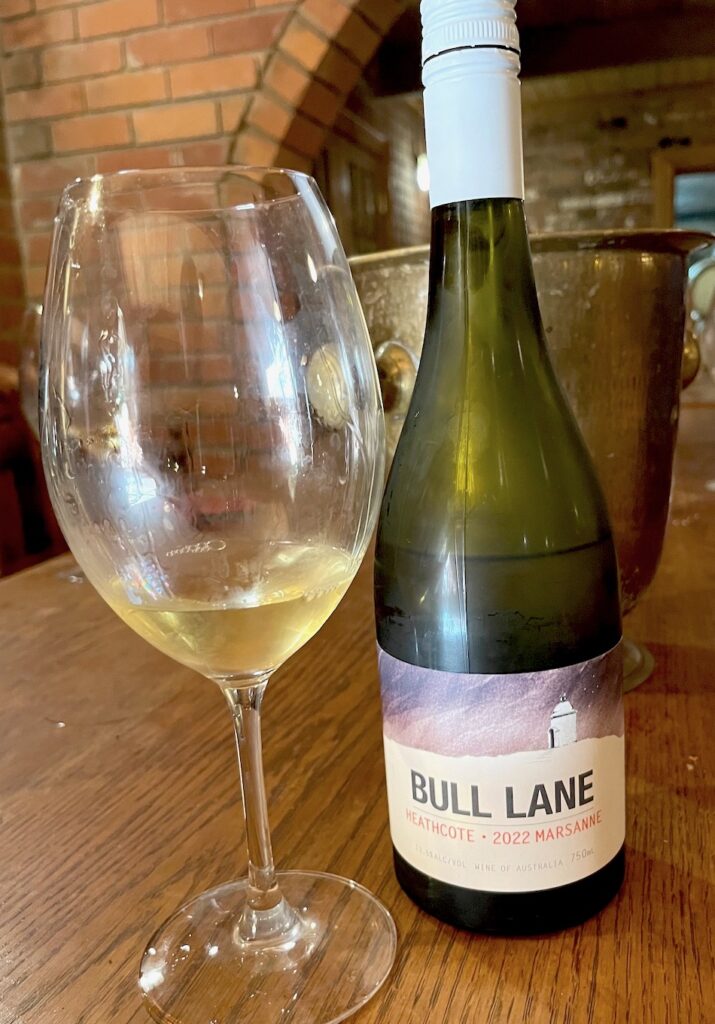
The Marsanne gives a Nashi pear character. There’s also quince, hazelnut, and that lanolin, ‘wet dog’ texture going on. The lower acidity lets the phenolics really come out – with a lovely astringent good-bitterness present, giving width but also some focus. Simon tells me when he was talking to Jean-Louis in France about Marsanne and said “I just don’t get it, we don’t have wines like this in Australia” to which he got the reply “You’re a big guy from a big country and you don’t like big wines? What’s wrong with you?”
Of course, Thomas Jefferson described White Hermitage as being the greatest wine in France. In Australia if someone drinks a white wine they will look to eat something crisp and fresh, maybe seafood; but the French have a history of richer foods, and the wines to match.
The Southern Hemisphere might be seeing a shift in consumers towards Pinot Gris, say, from Sauvignon Blanc. From something tight and crisp, to something with extra texture and flavour. A white that could be drunk in the cooler months as well as just being a picnic wine.
As a treat, I get to taste the first vintage wine of the Grenache from the vineyard I’d been looking at. There’s a delicious pink grapefruit character, alongside the raspberry you’d expect. One of Simon’s favourite wines is Chateau des Tours, the Cotes du Rhone of Chateau Rayas – a wine of tremendous fragrance and charm, which is what they would love to emulate with this Grenache. This has enough peppery, savoury character to balance out the lush fruit and the pink candyfloss note. Like a big juicy jam doughnut through the middle, but then a tangy, dry finish.
From the same vineyard near Toobarac – which is about the coolest part of Heathcote, a 2022 ‘Osicka Selection Shiraz’ is perfumed with cayenne pepper and white pepper. Rich and ripe, with a savoury note of forest floor, grilled meat and spice. A plushness on the palate, but with a ‘terracotta’ element that is very Rhone. And the Bull Lane Shiraz comes from a single vineyard north of Heathcote, on the Mt Camel range. They’ve been making it for ten years, and the grapes will ripen at least a month earlier than the ones from Toobarac. Some bitter chocolate, plum and blackberry flavours. The seamless silkiness is probably down to the tannin manipulation that Simon talked about earlier.
Simon had been Head Winemaker at Hardy’s immediately before coming back to help his Dad. He and partner Alison looked around and wanted to make a good, interesting Heathcote wines around the sub-$30 range. With the standard of fruit for sale, they thought you should be able to make wines for that market. At that stage they were the first to plug that gap. In some ways it is an anomaly as people wouldn’t realise the focus and attention that the wine gets, and is still that price.
A 2021 Heathcote Shiraz is next. Heroic tannins here – from an old, dry-grown vineyard, and spending four weeks on skins, with all the pressings then put back in. There is an unctuousness though, not a toughness. A distinctive dutch liquorice character too. Blueberry, cassis and damson plum, with a juicy salinity to the acidity. Simon talks of good bottles of this wine from the 1970s that are still drinking well. With better conditions, and sealed under screwcap… these wines should be just as good in fifty years.
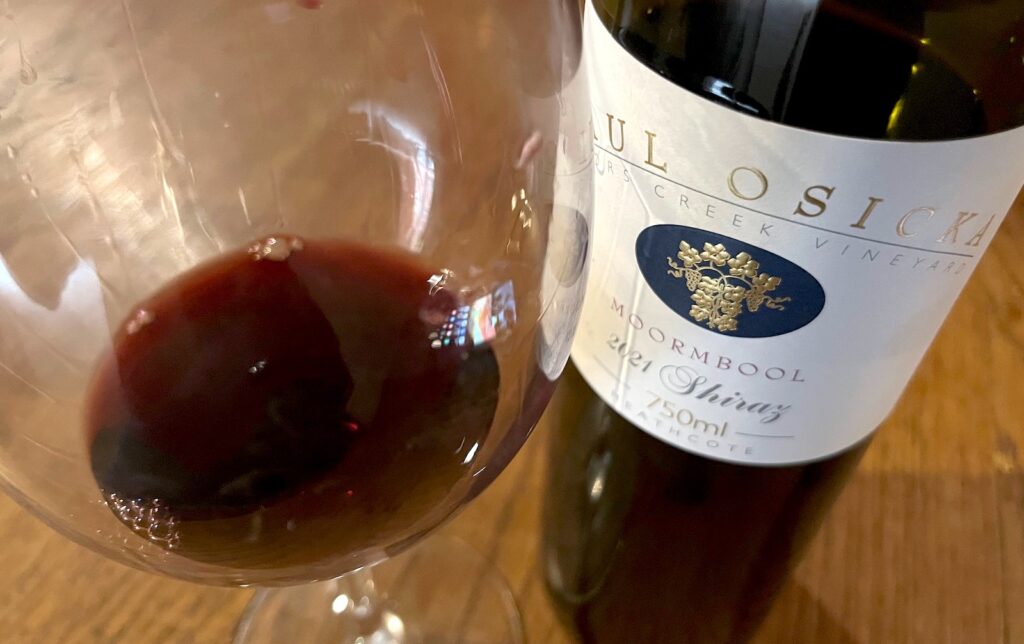
Simon makes a point that I’ve often echoed to winemakers in the past. “As a small winemaker, you don’t have to make wines that everyone likes – you just need to make wines that enough people love!” Then that works.
Another Shiraz – 2021 Moormbool Shiraz – appears. It is made if they think that a particular part of the vineyard offers up something special or unique. It’s not a question of quality – just a difference of expression. It has a delicacy and fragrance that is up another notch – I’d describe it as an understated version of Heathcote Shiraz. It has a ‘mouth perfume’ to it as well – there’s probably a fabulous french word for it. Again, the tannins here are so complete and soft.
Simon has us salivating with talk of “a really thick T-bone steak that I cooked in the pizza oven last night, and I opened up a couple of Cabernets – one of which was this one here”. They have planted more Cabernet and Cabernet Franc. This Cabernet Sauvignon has the distinctive graphite and cassis notes, plus eucalyptus on the nose. It was four 300l barrels, and one of them new french oak. Simon has an interesting point to make about the mint – “It’s the terroir of Australia. You can’t escape it. One of the reasons we put in all that equipment is to allow us to weed out all the extra material”. He digs out a photo on his phone and shows me “That’s a gum leaf in the middle of a bunch. That little leaf has fallen in there and the berries have formed around it. And the only way you can do something with that, is, as it is going through our process, to have someone watching the fruit at the end, so they can pull it out.
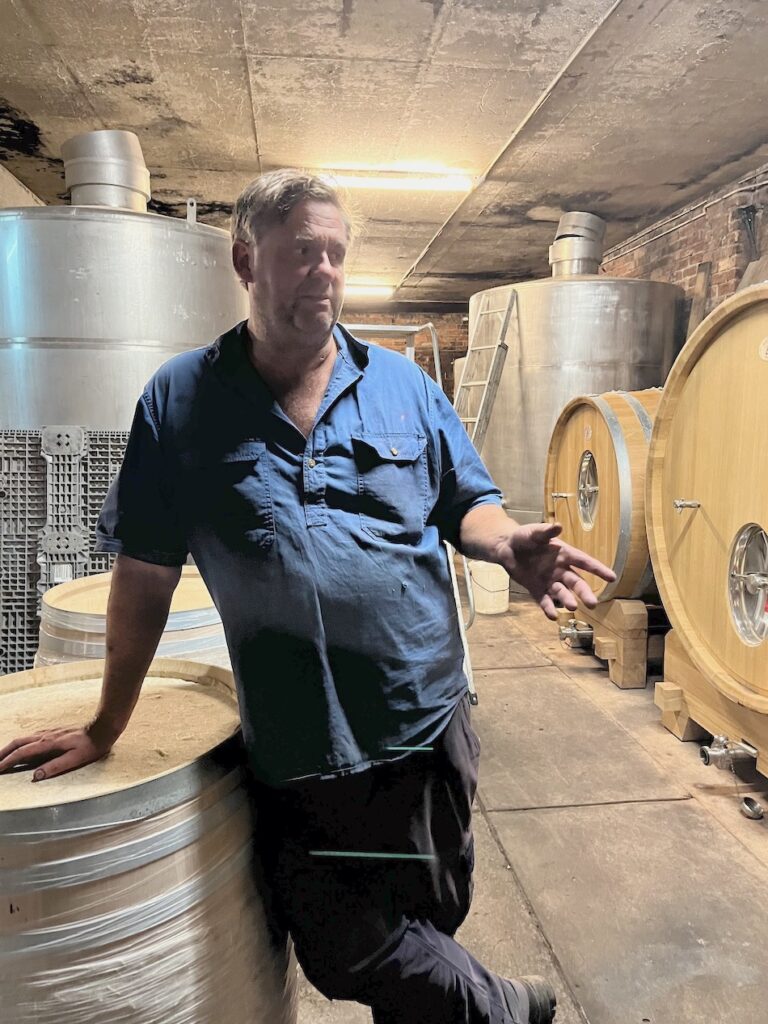
If you walk in the Australian bush, in the morning you can just smell it everywhere. If you look at pretty much any Australian wine there will be some level of it in there. It’s just whether or not it is a distraction. It’s probably something we want to celebrate because it is part of our wine. We also have a cigar box character here – that is part of the make-up of Cabernet, but oak plays an influence in that as well. It can be hard to divorce the natural character of the Cabernet from the oak.
I’m happy to push the ripeness of our Shiraz more than I would push the ripeness of our Cabernet. I think if you start to see any give in the tannin in Cabernet berries, you’ve lost it, because then you lose the fragrance and you lose the difference between Cabernet and Shiraz at that stage.
Most of our picking decisions on Cabernet is based upon when the fruit just starts to give a little bit. The skins can be brittle and get necrosis quite easily and start to die off. That happens sometimes before the fruit is quite ready. But if that starts to happen, you start to lose fluid – particularly in a hot year – and you start to get jammy characters”.
Osickas have been making good Cabernet Sauvignon for decades. There’s a patch of Cabernet in the old vineyard from the ‘50s, alongside some Cabernet Franc, and they have made a wine off just that in the past, but only three times! Only one or two barrels of very special wine. They also make a Cabernet from the original plantings of the well-regarded Balgownie vineyards in Bendigo. Simon and Tobias Anstead (best known for Tellurian wines) made it – and Tobias had worked at Balgownie for ten years, so was able to source the fruit. Balgownie used to be considered one of Australia’s great wineries – back in the ‘70s and ‘80s, so Simon does admit that he considered it amazing that they were able to buy the fruit, such was the quality of it.
Going back, Simon’s father had a reputation for making good fortified wines; winning the Trophy for Best Port at Rutherglen. He was the first winemaker from outside the region to win it, then won it three years running. And I try a 42-year old wine which is a blend of that material – Shiraz, fortified with Brandy spirit. It has Christmas Cake in-a-glass flavours – rich, nutty and dense. It’s a wonderful finale to a visit to this fine old Estate – where the family ethos runs deep, and the wines show no sign of losing that finesse and quality.
